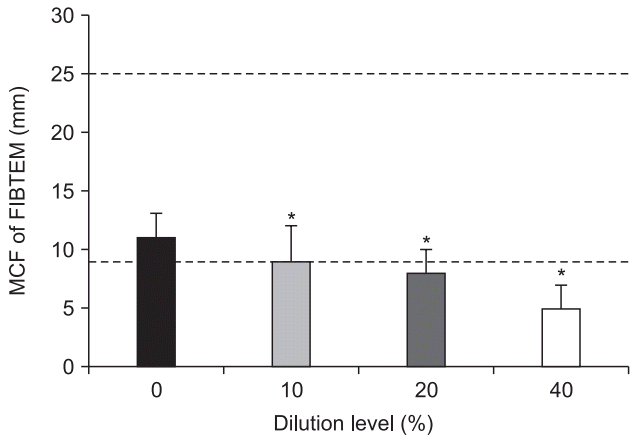1. Rassweiler J, Teber D, Kuntz R, Hofmann R. Complications of transurethral resection of the prostate (TURP)--incidence, management, and prevention. Eur Urol. 2006; 50:969–79.

2. Ekengren J, Hahn RG. Blood loss during transurethral resection of the prostate as measured by the HemoCue photometer. Scand J Urol Nephrol. 1993; 27:501–7.

3. Friedman NJ, Hoag MS, Robinson AJ, Aggeler PM. Hemorrhagic syndrome following transurethral prostatic resection for benign adenoma. Arch Intern Med. 1969; 124:341–9.

4. Doll HA, Black NA, McPherson K, Flood AB, Williams GB, Smith JC. Mortality, morbidity and complications following transurethral resection of the prostate for benign prostatic hypertrophy. J Urol. 1992; 147:1566–73.

5. Mebust WK, Holtgrewe HL, Cockett AT, Peters PC. Transurethral prostatectomy: immediate and postoperative complications. A cooperative study of 13 participating institutions evaluating 3,885 patients. J Urol. 1989; 141:243–7.
6. Shin HJ, Na HS, Jeon YT, Park HP, Nam SW, Hwang JW. The impact of irrigating fluid absorption on blood coagulation in patients undergoing transurethral resection of the prostate: a prospective observational study using rotational thromboelastometry. Medicine (Baltimore). 2017; 96:e5468.
7. Olsson J, Nilsson A, Hahn RG. Symptoms of the transurethral resection syndrome using glycine as the irrigant. J Urol. 1995; 154:123–8.

8. Hahn RG. Fluid absorption in endoscopic surgery. Br J Anaesth. 2006; 96:8–20.

9. Hahn RG. Fluid absorption and the ethanol monitoring method. Acta Anaesthesiol Scand. 2015; 59:1081–93.

10. Ozmen S, Koşar A, Sayin A, Aydin C, Yavuz L. Effect of transurethral resection of the prostate on blood coagulation test results. Urol Int. 2003; 70:27–30.

11. Kashuk JL, Moore EE, Sawyer M, Le T, Johnson J, Biffl WL, et al. Postinjury coagulopathy management: goal directed resuscitation via POC thrombelastography. Ann Surg. 2010; 251:604–14.
12. Johansson PI, Stensballe J. Effect of Haemostatic Control Resuscitation on mortality in massively bleeding patients: a before and after study. Vox Sang. 2009; 96:111–8.

13. Carroll RC, Craft RM, Langdon RJ, Clanton CR, Snider CC, Wellons DD, et al. Early evaluation of acute traumatic coagulopathy by thrombelastography. Transl Res. 2009; 154:34–9.

14. Levi M, Meijers JC. DIC: which laboratory tests are most useful. Blood Rev. 2011; 25:33–7.

15. Müller MC, Meijers JC, Vroom MB, Juffermans NP. Utility of thromboelastography and/or thromboelastometry in adults with sepsis: a systematic review. Crit Care. 2014; 18:R30.

16. Shin HJ, Na HS, Lee S, Lee GW, Do SH. The effect of hyperglycemia on blood coagulation: In vitro, observational healthy-volunteer study using rotational thromboelastometry (ROTEM). Medicine (Baltimore). 2016; 95:e4703.
17. Shin HJ, Park HY, Na HS, Hong JP, Lee GW, Do SH. The effects of Plasma-Lyte 148 solution on blood coagulation: an in-vitro, volunteer study using rotational thromboelastometry. Blood Coagul Fibrinolysis. 2018; 29:446–50.
18. Roche AM, James MF, Bennett-Guerrero E, Mythen MG. A head-to-head comparison of the in vitro coagulation effects of saline-based and balanced electrolyte crystalloid and colloid intravenous fluids. Anesth Analg. 2006; 102:1274–9.

19. Hahn RG, Berlin T, Lewenhaupt A. Factors influencing the osmolality and the concentrations of blood haemoglobin and electrolytes during transurethral resection of the prostate. Acta Anaesthesiol Scand. 1987; 31:601–7.

20. Whiting D, DiNardo JA. TEG and ROTEM: technology and clinical applications. Am J Hematol. 2014; 89:228–32.

21. Bergeron ME, Ouellet P, Bujold E, Cote M, Rhéaume C, Lapointe D, et al. The impact of anesthesia on glycine absorption in operative hysteroscopy: a randomized controlled trial. Anesth Analg. 2011; 113:723–8.
22. Gravenstein D. Transurethral resection of the prostate (TURP) syndrome: a review of the pathophysiology and management. Anesth Analg. 1997; 84:438–46.
23. Estes CM, Maye JP. Severe intraoperative hyponatremia in a patient scheduled for elective hysteroscopy: a case report. AANA J. 2003; 71:203–5.
24. Molnar BG, Magos AL, Kay J. Monitoring fluid absorption using 1% ethanol-tagged glycine during operative hysteroscopy. J Am Assoc Gynecol Laparosc. 1997; 4:357–62.

25. Ghadimi K, Levy JH, Welsby IJ. Perioperative management of the bleeding patient. Br J Anaesth. 2016; 117(suppl 3):iii18–30.

26. Ekseth K, Abildgaard L, Vegfors M, Berg-Johnsen J, Engdahl O. The in vitro effects of crystalloids and colloids on coagulation. Anaesthesia. 2002; 57:1102–8.
27. Fagerström T, Nyman CR, Hahn RG. Bipolar transurethral resection of the prostate causes less bleeding than the monopolar technique: a single-centre randomized trial of 202 patients. BJU Int. 2010; 105:1560–4.








 PDF
PDF Citation
Citation Print
Print



 XML Download
XML Download